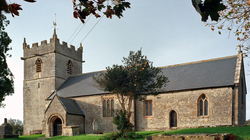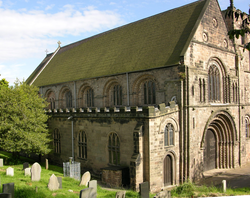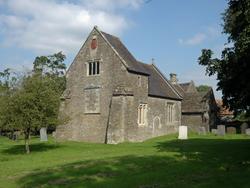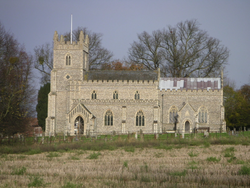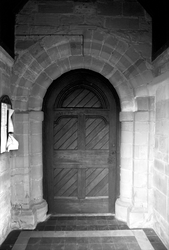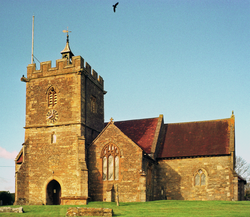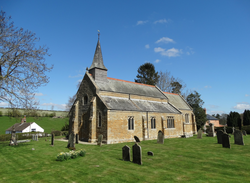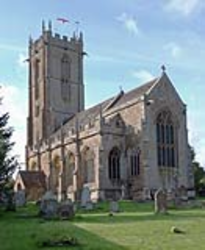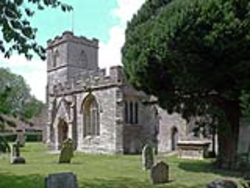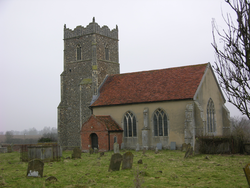
The Corpus of ROMANESQUE SCULPTURE in Britain & Ireland

St Mary (now)
Parish church
The parish of Moorlinch, which is on the southern slopes of the Polden ridge, lies 6 miles E of Bridgwater. Most of the land lies on Keuper marl, with irregular areas of clay and limestone on the higher slopes, and alluvium between the marl and the peat of Sedgemoor. The church of St Mary, which is in a prominent position and dates from the 13thc., consists of a nave with S porch, chancel and W tower. The outer doorway contains restored Romanesque work. The tub font is also perhaps Romanesque work.
Parish church, formerly Benedictine house
Tutbury is a large village in the west of Staffordshire, adjacent to the Derbyshire border. St Mary’s church is on the northern edge of the village, overlooked by the castle which stands on its motte to the W. The church consists of a 6-bay aisled nave with a SW tower in the W bay of the S aisle. The N aisle was added in 1820-22 by Joseph Bennett. The original presbytery was pulled down at the Reformation, and the present one is a replacement of 1866 by G. E. Street, funded by Sir Oswald Mosley, grandfather of the Fascist politician of the same name. The original nave may have had 2 more bays at the E, as well as transepts, presbytery and a tower over the crossing.
The church is celebrated for the elaborate Romanesque sculpture of its west front and S doorway, described here, and for its use of alabaster for the first time in England and for the only time in an external setting.
Parish church
The manorial hamlet of Laverton lies in rich farmland 8.5 miles S of Bath, about halfway between Frome and Norton St Philip. It is in a dip: the N-facing side is a valley of the Hennambridge Brook, a tributary of the river Frome. The manor house (now belonging to the Duchy of Cornwall) and church of St Mary are adjacent. The church, which is built of rubble, consists of an unusual W end, which Pevsner finds to be reminiscent of a westwerk (described as a tower in the HE listing), nave, N porch, chancel and vestry. It is mostly of the 11thc, with 15thc alterations. There was a restoration in 1859. The Romanesque elements consist of N (and possibly S) nave doorways and two windows in the western section.
Parish church
St Mary's was built 1n 1866-8, following the design of the medieval building it replaced. It retains an elaborate Easter Sepulchre of c.1500 installed by the Townshend family of local and national significance. The spiral shafts described here constitute the only Romanesque sculpture at the site.
Parish church, former
This is a simple aisleless church with a tower, nave and chancel. The earliest part is S door and sections of nave wall. There is a modern porch with neo-Romanesque decoration.
Parish church
Templecombe is situated on the A357 5m S of Wincanton and 12m E of Yeovil. The church, which is located in the centre of the village, has Norman origins, but was rebuilt in the 19thc. It consists of a S tower incorporating a porch, nave with N aisle and NE corner vestry and chancel. The font is Romanesque.
Parish church
Thoresway is a village in the West Lindsey district of Lincolnshire, consisting of a few houses, the church and farm buildings extending along a minor road to the SE of Caistor. St Mary's is a coursed ironstone rubble building with limestone dressings and consists of nave with late-13thc. arcades, a N porch, vestry and a chancel. It was rebuilt in 1879-80 by James Fowler, who added a W bell turret with a shirt spire over the W gable. The was formerly a 12thc. tower to the W of the present nave, and the E tower arch remains inside the church. Romanesque features are the N nave doorway and the W tower arch.
Parish church
Norton-sub-Hamdon is a village in South Somerset, located 5 miles W of Yeovil. Its name refers to the subordinate situation of the village over 100m below and to the SW of Ham Hill. The site of Norton was probably chosen because it almost nestles into a side valley from the river Parrett 1/2 mile W of the church. Being on Yeovil Sands (at an altitude of about 32m OD), it is blest with exceptionally fertile land and has a supply of excellent and very handsome building stone available only about 1/2 mile distant on Ham Hill. The present church of St Mary has 13thc origins but was rebuilt around 1500-1510. Some fragments of Romanesque sculpture were however incorporated in the inner face of the later medieval tower. This was damaged by lightning in 1894 and restored.
Parish church
The tiny settlement of Rimpton occupies a last block of relatively low-lying Somerset countryside nestling in a right angle of rather forbidding hills occupied by the frontier with Dorset. The church with attendant former manor house, at an altitude of about 40m OD, lies at the eastern extremity of the village, 300m from the Dorset border. The church of St Mary, which is built of local stone, has a cruciform plan with a W tower, nave, S porch, N and S transepts and chancel. Although it mostly dates from the the 13thc or later, the church may perhaps preserve some earlier features.
Parish church
The small priory of Austin canons at Letheringham was set in low, rolling country alongside the river Deben in east central Suffolk, three miles south of Framlingham. There is no discernable village; only what remains of the church, converted to parish use, and the Abbey Farm alongside it, surrounded by an empty arable landscape.
The present church of St Mary’s incorporates the two western bays and the tower of the priory church. It is tall and boxy, its walls rendered with mortar. It has a 12thc south doorway under a brick porch of 1685, with a Dutch gable, and buttresses have been added on the side walls and at the eastern angles. The 12thc north doorway survives too, but this has been reset facing inside the church. The south windows are of c.1300 with three-light intersecting tracery. There are no windows on the north side. The east end of the church fell into disrepair and was demolished in the 18thc, but part of its north wall survives as the churchyard wall, and to the north of this are ruinous remains of the monastic buildings. The east window, rescued from the rubble and reset, is a three-light affair with cusped intersecting tracery. The 14thc tower is of flint and rubble, unrendered, with diagonal buttresses decorated with flushwork, a polygonal SE stair and an embattled parapet with flushwork panels. The tower arch is tall and incorporates some 12thc material, and the church also has a 12thc capital, loose but displayed behind bars.
